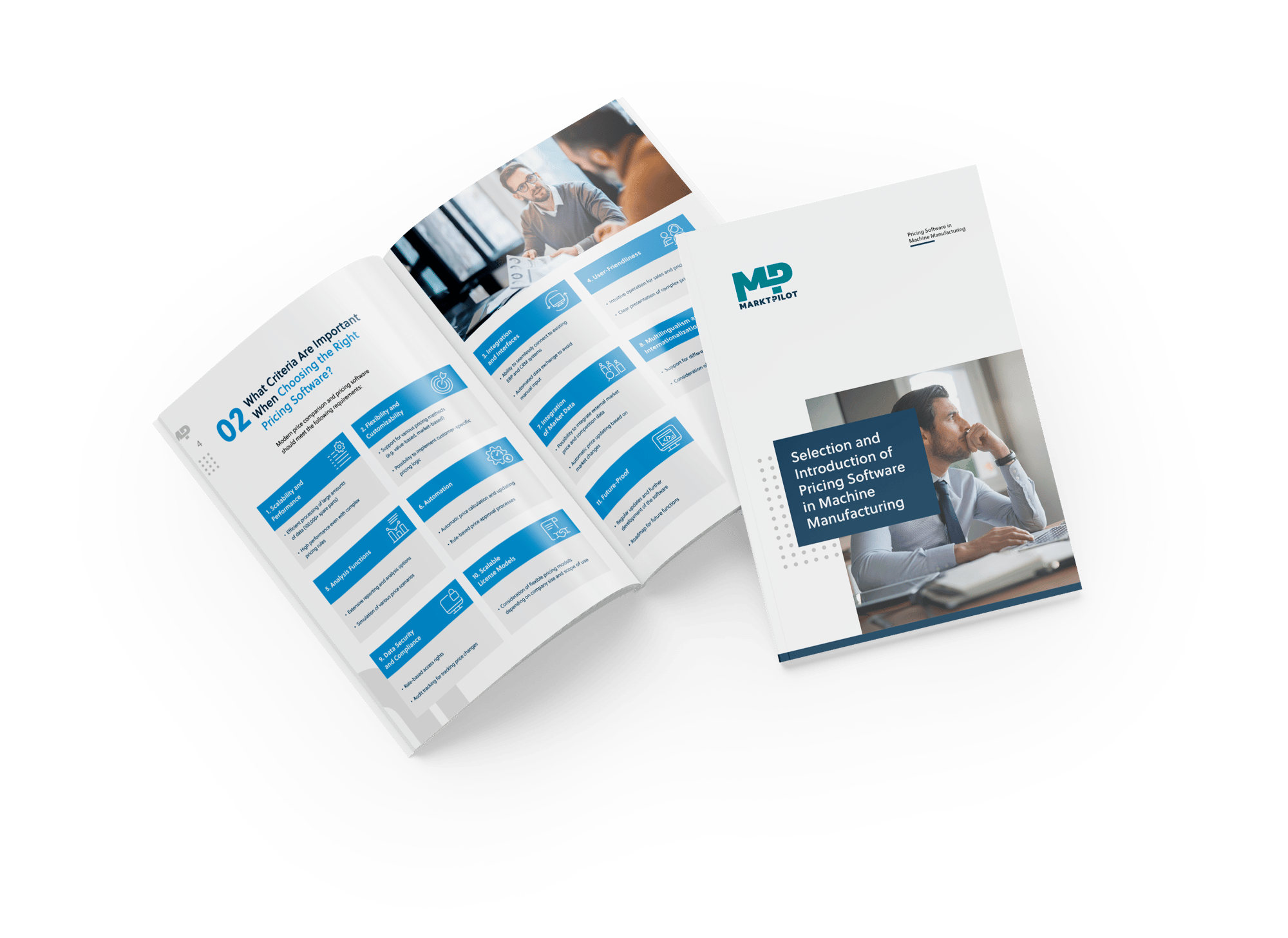Pricing Software for Machine Manufacturers: Principle, Benefits and Use Cases
Unlock the potential of AI-powered pricing software to revolutionize spare parts strategies in machine manufacturing. Discover how real-time market data analysis enables precise, demand-driven pricing to boost profitability. In this guide, learn the key benefits, features, and step-by-step processes for selecting and implementing the ideal pricing solution for your business.
Pricing Software for Machine Manufacturers: Principle, Benefits and Use Cases
A precise pricing strategy for spare parts is essential in machine manufacturing industry. AI-supported pricing software provides technological support for data-based, market-oriented pricing. It analyzes huge amounts of market data, enabling strategically calibrated pricing based on the current supply and demand situation in real time. On this page, you will find the fundamental principles of pricing software, highlighting its advantages for improving your company's profitability, along with its key functions and features.
In our comprehensive guide, you can learn more about the selection criteria for choosing the right pricing software tailored to your company's needs. Additionally, you'll gain insights into the step-by-step process of implementing this software effectively in your organization, ensuring it seamlessly integrates with your existing systems and enhances your pricing strategy.

What Is a Pricing Software?
Pricing software is designed to help a company determine the price for its service or goods. For machine manufacturers, and the after sales sector specifically, pricing software is a digital solution designed to facilitate the efficient and accurate determination of costs and pricing strategies for spare parts.
It relates to any commercially available application containing tools to automate pricing analytics, optimization, and execution to help businesses in their efforts to make efficient pricing decisions.
Compared to manual pricing, implementing a spare parts pricing software leads to increased efficiency, increased revenue, improved customer satisfaction, and a strong competitive edge.
Why Is Pricing Software Important in Machine Manufacturing?
The spare parts business is extremely volatile. Price fluctuations and increasing competition from alternative suppliers are causing problems for many machine manufacturers. Today, customers do not necessarily have to order their spare parts directly from the OEM, but can also use specialized internet platforms or offline dealers. There are often large price differences, although the manufacturers' spare parts prices are not necessarily always the highest. For example, studies have shown that more than 20 percent of spare parts sold by OEMs have the potential to be increased in price.
Many machine manufacturers are either unaware of the current market prices for their spare parts or are only insufficiently aware of them (“black box competition”) – and calculate either too high or too low. Their pricing remains inaccurate. Only around four percent of all purchased parts are currently priced in line with the market.
The absence of reliable market data and advanced pricing optimization software for automated, market-based spare parts pricing is a significant gap. Many companies calculate inaccurately because they do not take sudden market price changes into account in their pricing. They often work with outdated price lists, spreadsheets or self-developed analysis tools, thereby wasting a lot of sales potential – on average 17 to 20 percent.

Insufficient market data for spare parts leads to sales losses of up to 20 percent
This is a paradigm shift in pricing strategies. Instead of conventional pricing methods (e.g. cost-plus approach), spare parts pricing today requires significantly more data points (including purchase price, number of competitors, competitive prices, price potential, market density, price range, availability, delivery times, own win rates, sales and turnover volume).
Modern software for price comparison and pricing offers the necessary transparency. It provides comprehensive, up-to-date and comprehensible market data at individual part level - worldwide and regardless of the number of spare parts a machine manufacturer has in its portfolio. Achieving this level of transparency for 100,000 parts and more is virtually impossible with conventional methods and tools.
Having the best pricing software available, After Sales Specialists and Pricing Managers can calculate much more accurately and potentially generate more sales as a result. They also gain more certainty when negotiating with customers, as their pricing decisions are based on reliable data. In other words: By aligning their spare parts pricing closer to the market, companies strengthen their image as a fair service provider.
Who Benefits Most From a Pricing Software?
Pricing Managers
Pricing Managers are the “architects” of pricing strategies. With pricing software, they are equipt with the necessary data and tools to make informed decisions, optimize prices, and respond promptly to market changes.
CEOs
CEOs have a holistic view of their company’s performance. Pricing software provides insights for leaders into the financial implications of pricing decisions, allowing them to align pricing strategies with overarching business goals.
Revenue Growth Managers
Dedicated Revenue Growth Managers concentrate on increasing revenue by leveraging pricing software. This allows them to identify opportunities for upselling, cross-selling, and establishing optimal pricing points to maximize sales.
How Does Pricing Software Improve Profitability in Machine Manufacturing
Enhanced Profit Margins
Spare parts pricing software plays a crucial role in enhancing profit margins fo manufacturers by leveraging automation and algorithmic calculations. It ensures that each part's price reflects its market demand, maximizing revenue potential and contributing to improved overall profitability.
Data-Driven Decision Making
Modern pricing software incorporates advanced analytics capabilities that enable manufacturers to:
- Rapidly analyze vast datasets to identify pricing opportunities
- Optimize pricing strategies based on market conditions
- Forecast demand and adjust prices dynamically
This data-driven approach allows companies to make more informed pricing decisions to increase profit margins.
Market-Based and Dynamic Pricing
Pricing software enables a shift from simple cost-plus pricing to more sophisticated market-based and dynamic pricing strategies:
- Prices can be set based on real-time market conditions, including supply, demand, and competitor pricing
- Automatic price adjustments can be made in response to changing market factors
This flexibility allows manufacturers to stay competitive while maximizing revenue potential for each product and spare part.
Improved Efficiency and Accuracy
By automating pricing processes, software significantly improves efficiency and reduces the risk of manual errors:
- Centralized data management across pricing, promotions, and discounts
- Streamlined processes for price updates and adjustments
- Less reliance on error-prone spreadsheets
These gains in efficiency free up resources and ensure more accurate pricing decisions.
Better Visibility and Control
Pricing software provides enhanced visibility into pricing performance:
- Dashboards and forecasting tools offer real-time insights
- Detailed analytics allow for benchmarking against industry peers
- Centralized control ensures consistent pricing across regions and channels
This improved visibility enables manufacturers to quickly identify and address pricing issues, further optimizing profitability.
By leveraging these capabilities, machine manufacturers can optimize their pricing strategies, improve profit margins, and gain a competitive edge in the market.


A Brief Overview of Market-Based Pricing Strategy in Machine Manufacturing - Principles and Benefits
Find out more about the benefits of pricing software, the factors that play a role in pricing strategies and why intelligent price adjustments increase turnover and margins in after sales.
How Does Pricing Software Contribute to Improved Sales Volume?
Data-Driven Pricing Strategies
Manufacturing pricing software leverages advanced analytics to identify optimal pricing strategies:
- Analyzes historical sales data, market trends, and competitive pricing
- Determines price points that maximize both profit and sales volume
- Enables businesses to target specific customer segments more effectively
By relying on comprehensive data analysis instead of intuition for pricing decisions, companies can establish prices that are more effective in supporting sales.
Dynamic and Responsive Pricing
Modern pricing software enables dynamic pricing capabilities:
- Automatically adjusts prices in real-time on marked-based conditions
- Responds quickly to changes in supply, demand, and competitor pricing
- Enables businesses to capitalize on sales opportunities as they arise
This flexibility allows companies to stay competitive and capture additional market share.
Improved Customer Targeting

Pricing software provides insights that enable better customer segmentation:
- Analyzes customer behavior and willingness to pay
- Allows for personalized pricing strategies for different customer groups
- Helps businesses offer the right price to the right customer at the right time
By tailoring prices to specific customer segments, companies can increase conversion rates and overall sales volume.
Enhanced Competitive Positioning
Pricing software equips businesses with a competitive advantage through these features:
- Monitors competitor prices in real-time
- Enables quick responses to market changes
- Allows companies to offer competitive prices without sacrificing profitability
This ability to stay competitive while optimizing margins can again lead to increased market share and sales volume.
Optimized Promotions and Discounts
The best pricing software includes tools for managing promotions and discounts:
- Identifies the most effective promotional strategies
- Calculates optimal discount levels to drive sales while preserving profit margins
- Automates the implementation of promotional pricing
By running more effective promotions, machine manufacturers can increase their demand and sales volume. By leveraging these capabilities, pricing software allows to make more informed, data-driven pricing decisions that can significantly improve sales volume while maintaining or enhancing profitability.
1) Define Requirements
First of all, it is important to clearly define the specific requirements for spare parts pricing.
This includes the following points:
- Scope of the spare parts portfolio (number of parts)
- Desired pricing methods (e.g. value-based, competition-oriented)
- Required functions (price monitoring, simulation, reporting, etc.)
- Integration into existing IT systems
- Budget
2) Evaluate Options
Excel/Spreadsheets
- Advantages: Flexible, cost-effective, easy to use
- Disadvantages: Error-prone, performance problems with large amounts of data, lack of connectivity
Specialized Pricing Software
- Advantages: Powerful, extensive functions, good integration
- Disadvantages: High costs, complexity, customization effort
BI Tools
- Advantages: High-performance, customizable, cheaper than specialist software
- Disadvantages: Development effort, possible lack of special functions
3) Software Testing
Conduct a pilot project to test promising solutions and focus on the following:
- User-friendliness
- Performance with your data volumes
- Integration capability
- Support for the desired pricing methods
4) Decision Making
Carefully weigh up the costs and benefits of the various options! Take the following points into account:
- Total costs (licenses, implementation, training)
- Expected return on investment through optimized pricing
- Scalability and future-proofing
- Support and further development by the provider
Specialized pricing software may be worthwhile for complex requirements, while Excel or BI tools may be sufficient for smaller companies. It is important that the chosen solution optimally supports the company-specific requirements and can be integrated into the existing processes.

The Ultimate Guide to Market-Based Parts Pricing
Grow your revenue with market-oriented pricing and increase customer satisfaction at the same time. Our ultimate guide shows you how to identify spare parts prices below or above the market level and use these insights profitably.
Find out why conventional pricing approaches (e.g. cost-plus) are no longer up to date and how market-oriented pricing utilizes artificial intelligence to increase sales in the spare parts business.
Pricing Software - Business Scenarios and Case Studies
Software for price comparison and pricing in machine manufacturing industry can be utilized in numerous ways to optimize pricing strategies.
The versatile use of such software enables machine manufacturing companies to significantly professionalize their pricing in the spare parts business and exploit the full potential of their after sales business area.
Automated Price Calculation
The software can automatically calculate optimal prices for each individual spare part based on various factors such as manufacturing costs, market prices and the competitive situation. This enables dynamic and market-based pricing.
Reporting and Analytics
The pricing software creates comprehensive analyses and reports to monitor and optimize the effectiveness of prices, margin development and other KPIs.
Monitoring
The software can continuously monitor market prices for comparable parts and highlight deviations from your own price level. This enables you to stay competitive and make timely price adjustments.
Currency Management
For companies operating globally, the software can handle currency conversions and consider country-specific price adjustments.
Customer-Specific Pricing
Individual prices or discounts can be automatically generated for different customer groups based on customer history, purchase volume and other factors.
Supporting New Parts Pricing
When introducing new spare parts, the software can provide price recommendations based on comparative parts and market data.
Simulation and Analysis
Various price scenarios can be simulated in order to forecast their impact on sales and profits. The resulting findings can be taken into account for strategic pricing decisions.
Integration with ERP and CRM
By linking with other company systems, relevant data such as orders, stock levels and customer information can be included in pricing.
Segmentation and Classification
Spare parts can be automatically divided into different categories. This allows a differentiated pricing strategy to be developed for different segments.
Seasonal Price Adjustments
The pricing software takes seasonal sales fluctuations into account and adjusts prices accordingly to increase sales and margins.
DIEFFENBACHER Solves Pricing Complexity for Purchased Parts
THE CHALLENGE
Due to the lack of market insight and challenges regarding competitive intelligence, Dieffenbacher used to apply traditional cost-plus pricing for spare parts. In a challenging competitive environment with numerous competitors offering the same parts as Dieffenbacher, they were unable to swiftly adapt to market dynamics as required – with pricing being the key lever to change that.
Reflecting on the company’s future, Ralf Schmidt, Head of Global Service Wood & Recycling, faces two major challenges:
1.) Leveraging spare parts to create a sustainable competitive advantage
2.) Enhancing customer relationships to establish Dieffenbacher as a trusted and dependable partner for comprehensive and seamless spare parts provision.
THE SOLUTION
Thanks to MARKT-PILOT, Dieffenbacher succeeded in transforming their pricing strategy from traditional cost-plus pricing to market-driven spare parts pricing. This helps Dieffenbacher maximize parts revenue and profit as well as improve their customer relationships. Building and implementing an agile operating model in today’s spare parts business takes time and continuous optimization - which makes it even more important for Ralf Schmidt's team to embrace a long-term collaboration with MARKT-PILOT.
What are the Main Features of a Pricing Software?
Price Calculation
Price calculation in pricing software ensures accurate and consistent pricing, reducing errors and saving time, while also providing businesses with the flexibility to adapt to market changes and optimize pricing strategies for improved profitability and competitiveness. Additionally, it enables data-driven scenario analysis, and personalized pricing, enhancing overall efficiency and decision-making.
Efficient Processing and Analysis of Big Data for Enhanced Insights
Companies today are drowning in a flood of data, and many don't know how to make sense of it.
The advanced analytics capabilities of price comparison and pricing software allow companies to quickly analyze large amounts of data.
This enables them to make reliable, data-driven pricing decisions to maximize profitability. It also enables them to identify pricing opportunities, optimize existing pricing strategies and forecast demand.
Furthermore, the software's ability to analyze large amounts of data quickly and accurately allows companies to identify and track the impact of price changes on sales and profits.
The best pricing software is able to implement any company-specific pricing model in real time, regardless of its complexity.
Dynamic Price Adjustments
Dynamic pricing software can automatically modify prices based on real-time market conditions, such as supply, demand, and competitive pricing. For instance, airlines and travel companies are famous for using dynamic pricing, but moreover, it has become pervasive in many other industries over recent years. Dynamic pricing software does away with manual price adjustments by automatically determining optimal price points to maximize revenue and profit margins.
Centralized and Simplified Reporting
Markets might be complicated, but reporting doesn’t have to be. Pricing software can consolidate analytics, compliance, and reporting across regions, verticals, sales channels, and platforms so that you can keep track of performance centrally.
How Can I Get the Most out of My Pricing Software?
Unterschiedliche Preiswettbewerbsstrategien können sich erheblich auf die Marktposition auswirken, indem sie die Kundenwahrnehmung, die Wettbewerbsdynamik und den allgemeinen Markenwert beeinflussen.
In dynamic markets, OEMs must consistently update their pricing and pricing strategies in order to capitalize on revenue and profitability. Pricing software ensures that pricing aligns with market trends and customer demands. As a result, this responsiveness to changes in costs and competition also helps you to maintain a competitive edge.
Use Analytics for Decision-Making
Leveraging analytics is key for making informed pricing decisions. Additionally, OEMs can gain valuable insights into customer behavior and market trends by utilizing intelligent pricing software with advanced analytics capabilities.
What is the Impact of Pricing Software on Business Performance?
Software for pricing significantly influences business outcomes.
Enhanced Profit Margins
Pricing software is crucial in optimizing profit margins for machine manufacturers. It utilizes automation and algorithmic calculations to ensure that the pricing of each part aligns with market demand, thus optimizing revenue potential and increasing the manufacturers' overall profitability.
Improved Sales Volume
Pricing software plays a major role in improving sales volume by identifying optimal pricing strategies. Better pricing insights allow businesses to target specific customer segments and optimize their offerings, helping them stay competitive and capture additional market share.
Competitive Advantage
By analyzing competitor prices, businesses can gain a competitive edge by offering more competitive prices without sacrificing profitability. Utilizing a pricing software can differentiate a business from its competitors.
Increased Customer Satisfaction
Pricing software can help to increase customer satisfaction by offering strategic prices that align with customers’ expectations. This further improves the overall customer experience, customer loyalty and retention.